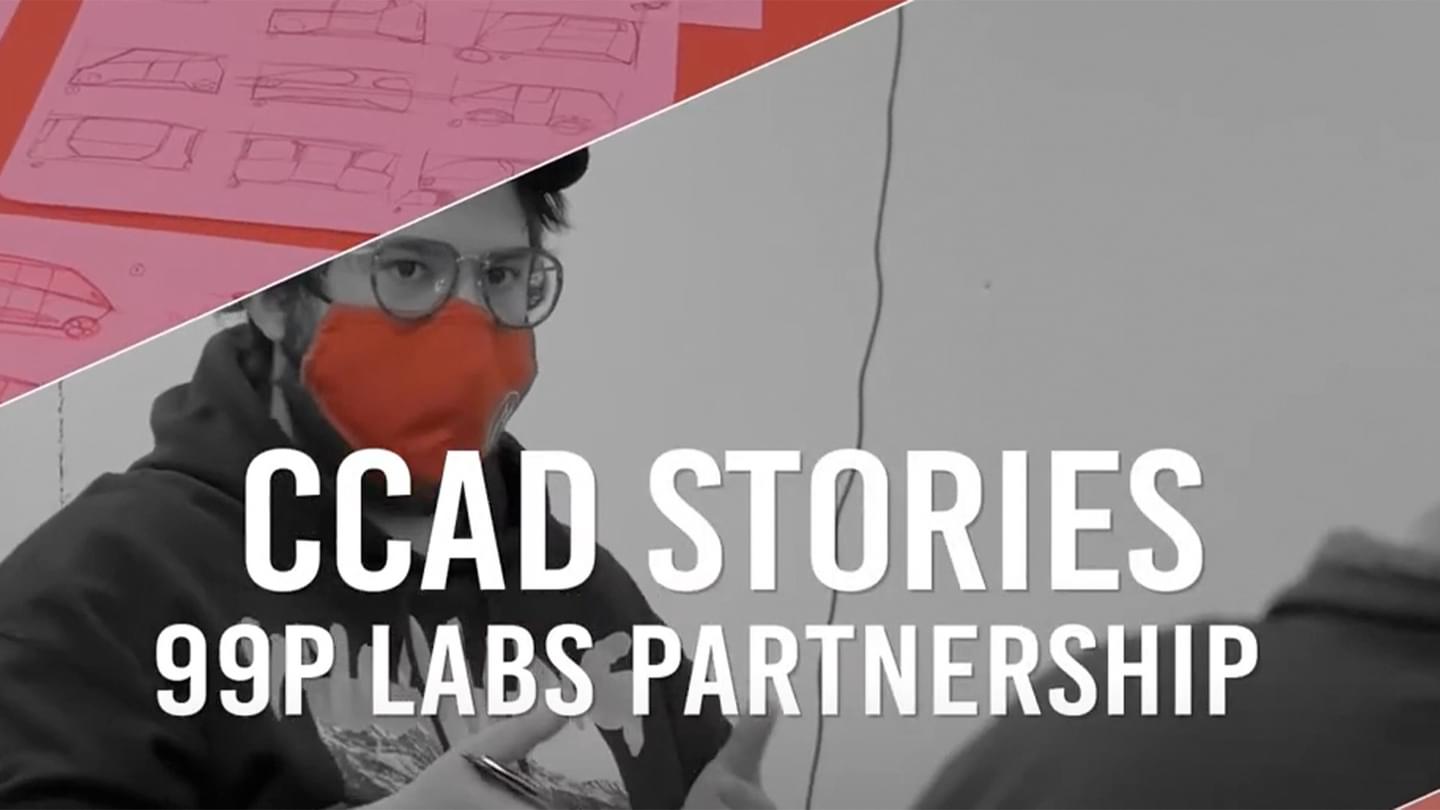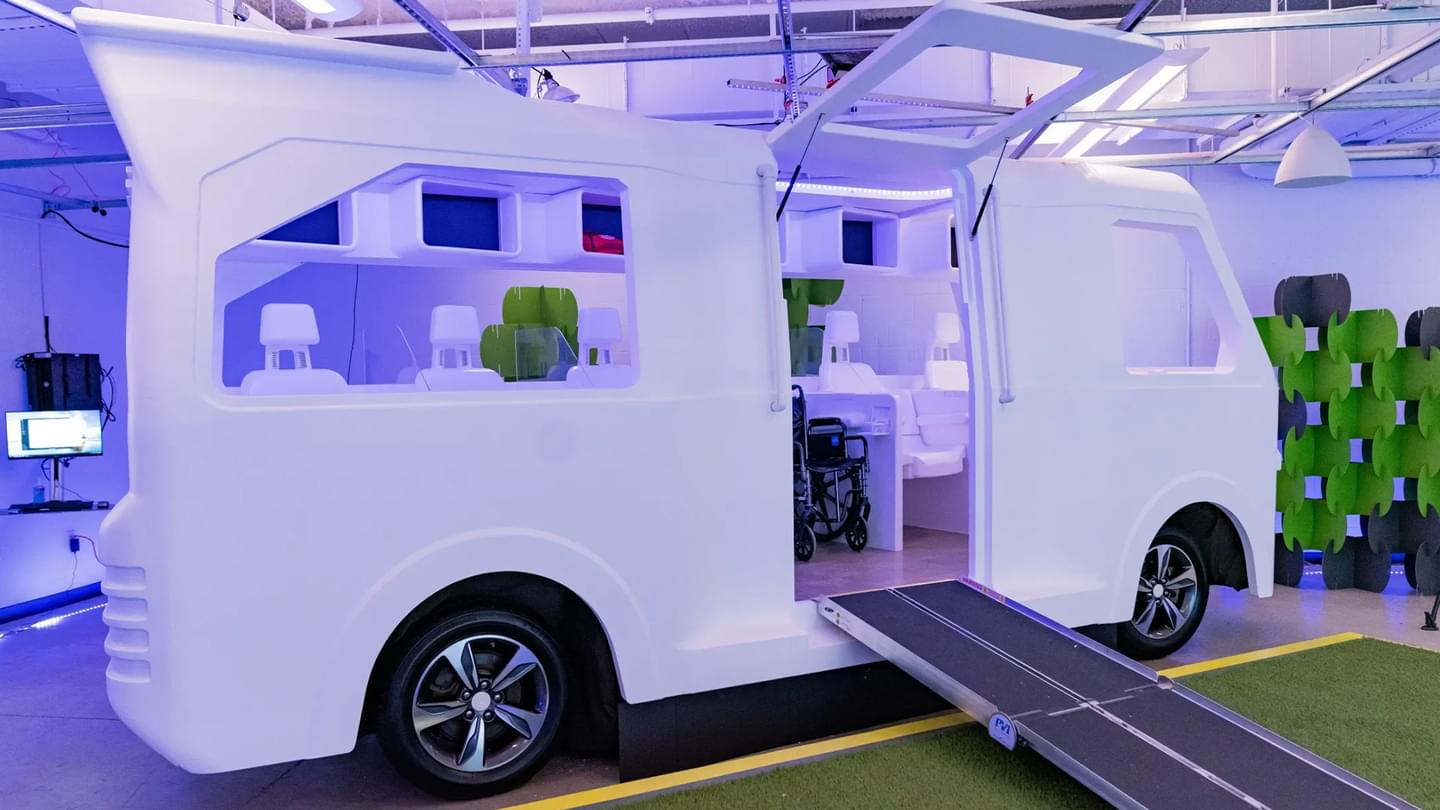
What’s the future of transportation? CCAD has the answers, and collaboration is key.
The group of people who want to drive is shrinking. And the group of people who want convenience is growing. In 2019, 99P Labs, backed by Honda and The Ohio State University, approached Columbus College of Art & Design with a specific challenge: to reimagine a shared mobility vehicle that fits the needs of three key customers: millennials, older adults, and rideshare service providers. The outcomes would include research on these demographics and a real-life prototype, called a “buck” in the automotive industry.
And in the spirit of creative collaboration, CCAD students and faculty were ready and willing to take on the task.
The work was done over the course of five semesters (with students logging more than 11,000 hours of design work) through CCAD’s Creative Careers & Collaboration program, which connects with forward-thinking organizations to create collaborative learning partnerships with CCAD’s expert faculty, talented students, and skilled alumni to solve the real-world challenges of today and tomorrow.
Meet Meraki
Meraki is the Greek word used to describe doing something with soul, creativity, or love. And it was the name that 99P Labs selected from a variety of ideas generated by CCAD Graphic Design students to capture the prototype’s essence. It was with a deep sense of creativity and passion that in spring of 2021, students unveiled their research, a new vehicle prototype, an app for hailing rides, and a virtual reality experience that allowed 99P Labs to see into the future.

Joan Smith, Associate Director of Mobility Innovation for 99P Labs, was surprised—and pleased—with the tenacity and energy CCAD provided for a project of such significant scope and size.
CCAD students are relentless in their pursuit of finding exactly the right solution for these customers—all of the customers,” Smith says. “Not only am I asking them to create an automotive project, which is a challenge all by itself, but I’m asking them to do it in a way that serves three totally different customers with three totally different scope of needs. They took on that challenge, full steam ahead, and they did a fantastic job.”
Going deeper into design research
Much of the design process is developing an understanding of the people who will be using the product, particularly their desires, needs, and fears. For this project, the consumer research and the prototype creation were of equal importance for 99P, as one informs the other.
CCAD’s research relied upon collaboration across majors—the Graphic Design, Animation, Film & Video, and Product Design programs worked together in this in-depth design project—as well as with external entities and end users.
Industrial Design students rode along with Central Ohio Transit Authority and SHARE Mobility as part of their research, trained with Age Friendly Columbus, and conducted 17 co-creation sessions with potential end users to capture what was truly needed and to understand riders’ anxieties around autonomous vehicles. During the co-creation sessions students provided photos and words and asked users to walk through their existing experience as well as their ideal experience.
Additionally, the Industrial Design students visited the University of Michigan to experience the Mcity Driverless Shuttle, and they attended the Consumer Electronics Show in Las Vegas in January 2019 to observe industry trends. All of this research drove the creation of three increasingly refined full-scale prototypes that were further informed by user testing.
The takeaways
The students’ research unveiled valuable insights for 99P, some that their team had never considered before.
The research showed that Millennials are less interested in owning their own vehicle and prefer to use their commute to decompress. Older adults want to maintain their independence when they don’t feel comfortable driving. Even so, the students discovered, there remains an element of fear—presently overlooked by the industry—connected with autonomous vehicles. Their solution? Replace the driver with an attendant who responds to the needs of the passengers through an app, providing riders with an enhanced sense of security and confidence. The soul of the new vehicle concept is trust, control, and dignity.
Additionally, through interviews and observations at the Consumer Electronics Show, students learned that industry leaders were framing their vision of the future with the assumption that all users would connect with their particular brands, rather than choose from a variety of options as they do now in their own mobility decisions.
CCAD students design with intentional inclusivity in mind
Inclusivity drives the marketplace. And from the project’s onset, students focused on designing a vehicle that was inclusive for all users, including people of various ages and those who use mobility equipment. Students considered the full rideshare experience from couch to destination, developing an app for hailing rides, customizing an individual’s seat preferences, and asking for assistance before and during the ride experience.
Miguel Alemany (Industrial Design, 2022) says interviews with potential users, including people who use ambulatory devices such as wheelchairs, brought to light considerations that the team didn’t find through more technical ADA-centered (Americans with Disabilities Act) discussions.
“Hearing a lifelong wheelchair user talk about the ways she’s felt either forgotten or unvalued on public transportation, that’s where we really started to understand how to design it,” says Alemany. “She doesn’t want her own entrance to be put at the back of the bus, or to make other riders wait while she is loaded or unloaded. The driver is rarely trained on how to properly use the ramp or tethers, so she often feels unsafe. She wants to have the same experience as everyone else.”
Conversations like these led the students to design a single side entrance with a ramp that every rider uses, and seats in each spot in the vehicle that flip up to accommodate users with wheelchairs.
Ryan McManus, CEO of SHARE Mobility, says CCAD students’ work blew him away.
It was an audacious plan to create a concept vehicle,” says McManus. “But the students did it—and they produced much more than that. They considered where transportation is going and designed a holistic experience for those who are always passengers. It is encouraging to see the compassion and humanity that the students applied with physical and experiential design.”
CCAD’s cross-disciplinary approach pays off
Design research. Prototype production. Project management. Branding. Virtual reality environments. Polished presentations. And so much more. The CCAD students were asked to take on a variety of tasks and work with peers within their own majors and across program areas to deliver 99P Labs with a prototype with the potential to change transportation—and the world—for the better. And they did just that. Here’s a brief overview of what they accomplished:
Graphic Design students established the brand for the prototype, developed a marketing campaign for it, and built a ride-hailing mobile app.
Animation students developed a virtual reality environment for Meraki, allowing users to make simulated adjustments to the prototype, including adding a privacy divider and changing the lighting, air flow, and the vehicle’s color.
Film & Video students produced several documentary films about the project.
Product Design students conducted the design research, produced thousands of sketches, material experiments, digital interfaces, and created full-scale concept models (aka “bucks”).
Undergrads gain real-world experience
“The most rewarding part of my project management role has been getting to watch my team succeed and progress through the project,” says Gage Holtz (Industrial Design, 2022), who started the project in the spring of 2020 on the research team, and then stepped into the project manager role for the final semester. “Seeing each of my peers grow and adapt to new roles that they had not previously experienced—and succeed with that work—has been very exciting.”
It’s these types of lessons that students will carry with them into the workforce, says Nicole Monahan, Director of Corporate & Community Partnerships at CCAD.
“There is simply no substitute for the deep, multidisciplinary learning that happens when our talented students and faculty take on a real-world challenge like the one that 99P Labs brought to us,” says Monahan. “It is thrilling to watch the students become confident creative leaders right before our eyes because they’ve put in the work, done the research, and built something extraordinary. Our learning partners at 99P Labs treated them like future colleagues and our students rose to the challenge. There is nothing more satisfying than knowing that when these young people graduate CCAD, they’ll leave with the ability to immediately make an impact wherever they go.”
By the numbers
The 99P Labs project involved a CCAD team of:
Learn more about the Graphic Design, Animation, and Film & Video majors at CCAD or apply here. Discover more Creative Careers & Collaboration.
